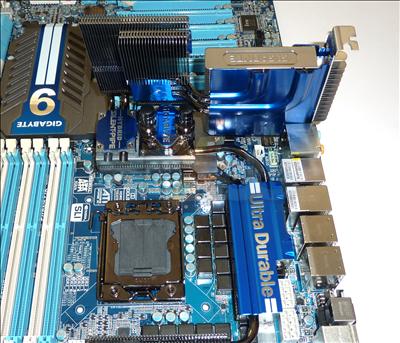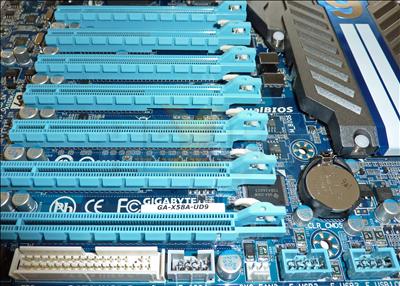A plethora of goodies
It is feasible to have both the block and SilentPipe 2 working in tandem, increasing cooling performance, but non-liquid-cooling users may want to remove the block.
Being X58, six DIMM slots are available, scaling up to DDR3 memory operating at 2,200MHz, and we expect most enthusiasts to fill them. Power and reset buttons - now staple fare for enthusiast-class boards - are close by.

This is why the GA-X58A-UD9 ships with two nF200 chips that hang off the X58 IOH. Add it all up together and total PCIe allocation means that you can run four graphics cards at x16 for either four-way SLI or four-way CrossFireX.
And here are the slots. Looking from the top the first, third, fifth and seventh slots all work at x16 electrically. The in-between slots operate at 8x. This means that you can have double-width cards arranged in a four-way grouping. Quad GeForce GTX 480s, anyone? The bridge-covering heatsink connects to the X58 IOH's and whilst well-made, it doesn't feel very substantial.
Moving away from the cornucopia of PCIe laneage, the board also ships with two SATA6 ports - although a further two are confusingly coloured a SATA6-matching white - that are powered by a Marvell controller as well as USB 3.0 from NEC.

Gigabyte already has a well-established X58 chipset-based range of motherboards in the form of the 'UD3R, UD4, 'UD5, and 'UD7 boards. The GA-X58A-UD9 is one that's intended to appeal to the proper hardcore enthusiast who plans to run three or more graphics cards and the very latest hardware to match. We reckon it will cost well over £300 when it makes an appearance at etailers' listings. Worth it? Wait for the review next week.















